STEM Conference Gives Teachers the Courage—and the Tools—to "Do Science"
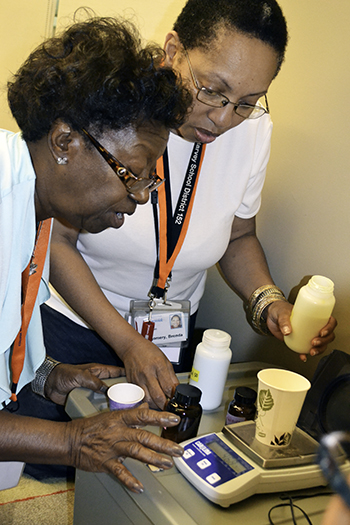
Brenda Montgomery (right) and another teacher do a hands-on activity during Joe Muskin's breakout workshop.
“I have never felt science was my strong suit. But attending this conference and participating in the workshops, it just gives you the courage to go and do science, and have fun with it, and not be afraid of it.” – Brenda Montgomery, Holmes Elementary 1st grade teacher
August 17, 2015
The 2015 Beginning Teacher STEM Conference on July 28 & 29 did more than impart courage to the approximately 125 new Illinois teachers who attended. The annual event, hosted by the College of Education’s Illinois New Teacher Collaborative (INTC) also equipped them with the know-how and the tools, including a raft of hands-on activities they could take back to their own classrooms.
Sponsored by Governor’s State University’s TQE grant, Illinois’ College of Engineering, and INTC, the conference packed a variety of STEM-education-related activities into a little over a 24-hour period— including keynote speaker Dr. Alan McCormack, past president of the National Science Teachers’ Association; formal and informal networking opportunities; plus 30 STEM breakout sessions.
However, according to INTC Assistant Director Nancy Johnson, this year’s conference, with its added emphasis on applying STEM via art, might have been called a STEAM (Science, Technology, Engineering, Art, and Mathematics) conference: “We’re not billing the conference as STEAM, but we have several sessions that are STEAM.” This included a STEAM Ed Chat given by Dr. Jennifer O’Connor, a professor of art education.
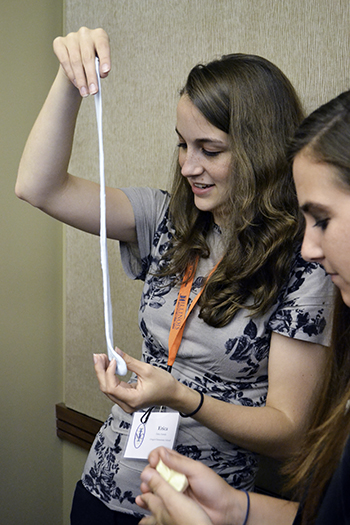
A conference paricipant plays with the "silly putty" type product she made during Joe Muskin's session. The scenario was: create new products for shoe beds, handle grips, or helmet padding. Based on whether or not they used an additive, participants could make up to 4 types of putty, then test them for how well they held their shape and absorbed energy to determine which would be the best for the new product.
According to INTC Director Chris Roegge, adding art to STEM's already multidisciplinary mix just makes sense: “At its base, it’s basically just integrating. We artificially divide these things into sort of arbitrary subject areas anyway, but in real life, it’s all mushed together. The more we do that, the better, I think.
“It probably ought to be STEEAM,” quips Johnson, “because without the use of English, you can’t do any of this.”
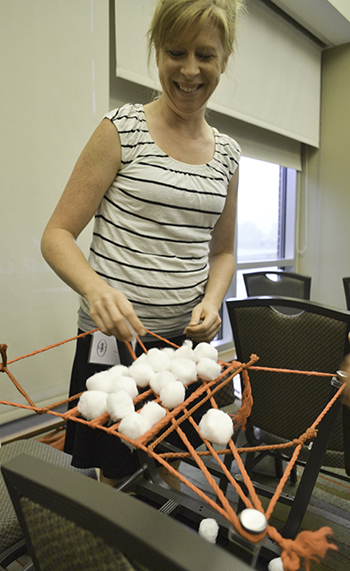
During one of the conference's STEAM presentations, a teacher in Sarah Livesay's Session, “Using Nature to Move Full STEM/STEAM Ahead in Early Learning!” makes a spiderweb in which other "insects" are trapped.
Brenda Montgomery, 1st grade teacher at Holmes Elementary in Harvey, Illinois, would actually agree: “That’s what’s exciting about STEM,” she explains. “Because you have the science; you have the technology; you have the engineering—which is just glorified problem solving; you have the math. But you also have reading and art and language arts, because you have to be able to communicate what you’ve learned, and essentially share your enthusiasm for what you know. So the fact that this conference is dedicated to that and gives teachers the tools, the strategies, and like I said, the courage that they need to go out and have fun, I think is just awesome.”
And sharing their enthusiasm with the teachers were a number of STEM education stars—from the Illinois campus and beyond.
Welcoming teachers was Dr. Roberta Johnson, wife of new Illinois President Timothy Killeen, a STEM educator herself in the Earth Science department.
Keynote speaker Dr. Alan McCormack also taught a breakout session geared toward middle school teachers: “Harry Potter, Imagineering, and Scintillating Simulations Preserve the Fun in Science.”
Other STEAM offerings included Laura Hetrick’s “Problem-Based Art, “Art and Sustainability” taught by Jennifer O’Connor, “Using Nature to Move Full STEM/STEAM Ahead in Early Learning!” by Sarah Livesay, and “Mathematics and Sculpture” by Dr. Diuanna Galante. One teacher who was particularly interested in the STEAM sessions was Emily Tschiggfrie, who teaches third grade honors class in Park Forest, Illinois' Mohawk Primary School.
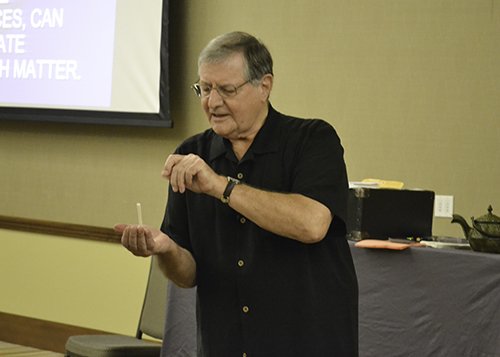
Keynote speaker, Dr. Alan McCormack, past president of the National Science Teachers’ Association, illustrates a concept during his breakout session for middle school teachers: “Harry Potter, Imagineering, and Scintillating Simulations Preserve the Fun in Science.”
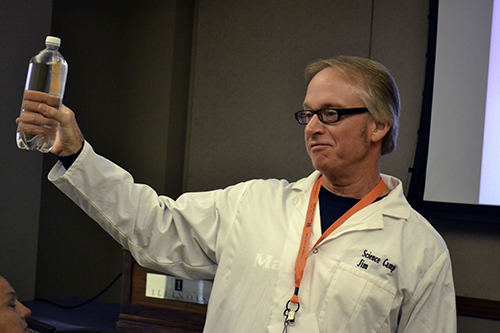
During his "The Friday Mystery” breakout session, James Sparks exhibits a Cartesian diver he made with a plastic bottle, water, and a mustard packet.
“Honestly, I love science,” she admits, “and we do a very extensive STEM program, and actually a STEAM program in our building. I wanted to start doing weekly STEAM activities with my third grade honors class. So it was available and it seemed like a really good opportunity to learn.”
Besides STEAM, the breakout sessions addressed a variety of subjects that covered all four disciplines of STEM. Representing science was renowned bee researcher May Berenbaum, who taught about her favorite insect in “Pollinator A-Bee-Cs.” Dave Leakey from the Parkland Starkel Planetarium addressed astronomy in “Of Dwarf Planets, Eclipses, and Light.”
A number of sessions addressed technology, including: “YouTube and Hollywood Are My Best Flippin’ TAs," presented by Eric Snodgrass, and Anastasia Hahn’s “Five Steps to Integrating Technology Into Your Elementary Classroom.”
Engineering was also well represented. Dan Green shared about robotics in “Using FIRST Robotics to Get Students Interested in STEM" (see final image below). Joe Muskin’s ever-popular Engaging Engineering Labs featured hands-on engineering activities teachers could take back to their classrooms.
Representing math was Claire Merriman, who presented “Exploration and Experimentation in Mathematics: Resources and Examples.”
Of course, a number of breakout sessions, including some of the above, were multidisciplinary, including Sarah Livesay, who presented “STEM Out with Biomimicry,” which in part involves innovations, including engineering designs (like Velcro) that mimic designs in nature, and Rebecca Wattleworth’s “Windmill for Environmental Study.” Also back by popular demand from last year’s conference was a STEM Careers Panel presented by Research Park researchers.
One intriguing, hands-on-activity-filled presentation was James Sparks’ “The Friday Mystery.” While the title itself is a mystery, this reporter guessed (correctly) that the presentation addressed keeping antsy kids who long for the school week to be done engaged on a Friday afternoon. Apparently Sparks randomly picks a Friday to do fun hands-on activities, such as building Cartesian divers using plastic bottles, water, and catsup or mustard packet "divers."
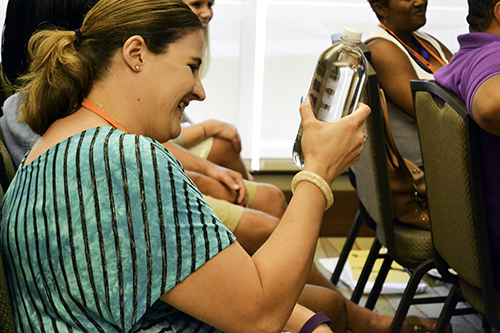
Emily Tschiggfrie, Mohawk Primary School third grade honors teacher appreciates the Cartesian diver made in James Spark's Friday Mystery session.
Third grade honors teacher Tschiggfrie was inspired by the Cartesian diver activity in Sparks’ session. “It was fun, and I kept thinking, ‘What a great way to incorporate Fun Friday for my kids, where you give them the materials and go, ‘Ok, what can you create?’ or ‘Can you tell me why this does this? And what other things might we use?’ Like if we change the catsup packet to something else. What other materials would you want to try? Would jelly work?’”
The conference was begun several years ago, when staff at INTC “identified STEM as a need area and decided to try something in that,” explains INTC Director Chris Roegge.
He goes on to explain that the conference features some of the same presenters year after year because they’ve proven to be effective.
“We find a formula that works, and we stick with it…because it’s a different audience each year,” explains Roegge. “Having speakers and presenters come back year after year after year, they’re being exposed to participants that they’ve not been exposed to before.”
What kind of impact is the conference having? Teachers are implementing the activities in their classrooms.
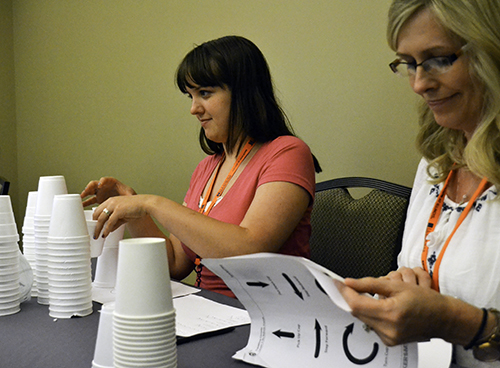
Two teachers in Todd Lash's "Communication, Collaboration, and Creativity through Computational Thinking" breakout session do a hands-on activity involving paper cups.
“It works,” explains Roegge. “The follow up data show that it’s popular, and it works. They’re taking some things back with them and actually incorporating them in their own classroom."
INTC doctoral student Amber Behrends, who has been studying the impact the conference has on teachers' classrooms, agrees. She says teachers who responded to last fall's follow-up survey gave: “very positive feedback":
"They were networking with new teachers as a result," she continues. "They were taking these strategies and trying them in their classrooms and felt they had improved an aspect of their teaching from being at these.”
According to Roegge, another important aspect of the conference is networking, which gives teachers the opportunity to “let their hair down,” so to speak.
“The opportunity for the new teachers, after their first year in, just to get together and network is so important. And we get that in our feedback each year, that the informal networking time that’s put into the conferences and then the time outside of the formal sessions, they value that very highly. I don’t want to say its cathartic, but maybe to a degree it is. To be able to debrief, and decompress with peers who share a common subject theory orientation."
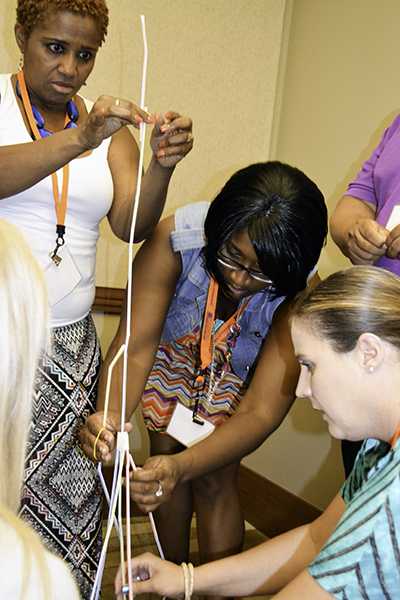
A team of teachers work together to build a tower out of straws during James Friday Mystery" session.
"And why not showcase what we have here?" adds Johnson, regarding the wealth of STEM education expertise on campus, some of which is featured during their conference.
The conference appears to be filling a much-needed niche, especially when it comes to equipping new teachers, especially primary teachers who did not specialize in a STEM field, to teach STEM. According to Montgomery, it not only equips teachers to teach students but to inspire them that they can have careers in STEM fields:
“The older, more traditional way of teaching science, it really is very offputting, especially for women,” explains Montgomery. She claims that it gives students the impression that “Scientists are just really deep; they’re very smart, and not just anyone can be a scientist.”
But Montgomery indicates that through the INTC STEM Conference, she has gained a new appreciation for and curiosity about science, which she tries to pass on to her students:
“What I love about this conference is that it focuses on the curiosity, because scientists are curious; it’s the only thing that makes them different—that they are curious. Science is not some mystical, ivory tower activity, that, in fact, it is interwoven in everything, and everything else is interwoven in science."
Story and photographs by Elizabeth Innes, Communications Specialist, I-STEM Education Initiative.
More: INTC STEM Conference, Teacher Professional Development, 2015
For additional istem articles about the INTC Beginning Teacher STEM conference, please see:
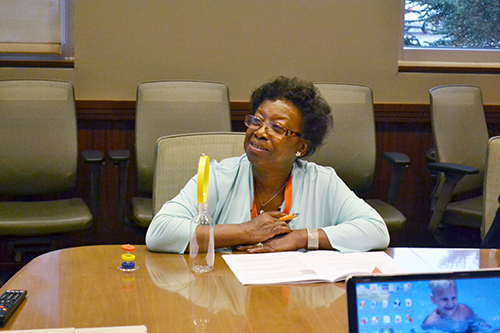
An Illinois teacher appreciates the "IC STEM! Ignite Curiosity with STEM" breakout session.
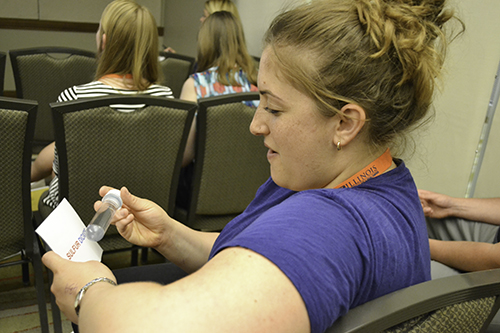
A teacher in Sparks' Friday Mystery session uses a "magnifying glass" created from a bottle of water to read words; the mystery was why, a certain distance from the paper, the words flipped upside down.
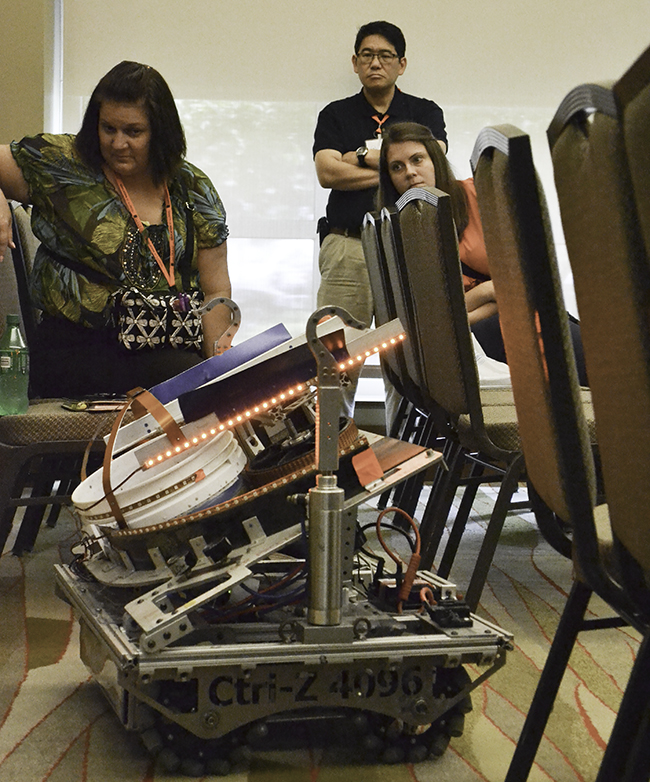
Several teachers watch a robot in action during Dan Green's session, "Using FIRST Robotics to Get Students Interested in STEM."